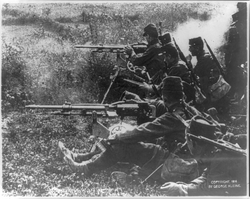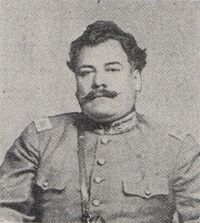
A French machine gun crew at the Battle of Chapultepec.
The Battle of Chapultepec was the decisive engagement of the Hundred Day War between France and the United States of Mexico. The battle resulted in a complete Mexican victory, and made General Emiliano Calles the most popular man in Mexico.
Operating from its beachhead in the city of Tampico, Durango, the French Expeditionary Force under General Jacques Beauchamp began its drive on Mexico City in mid-July 1914. The Mexican army under General Vincent Collins had been prepared for the advance, but fell back steadily in response to the determined French assault. On 13 August Mexican President Victoriano Consalus removed Collins from command of the Mexican defense and replaced him with Calles.

General Emiliano Calles.
Calles was forty years old, the youngest general in the Mexican army, and its only Mexicano general officer. Prior to his appointment in command of the army facing Beauchamp, Calles had been commander of the Durango district. Consalus' primary motive in choosing Calles was that he was available at the capital, but Sobel suggests that his choice was also meant to counter French efforts to suborn the Mexicano population of Durango.
Calles marched fresh regiments to the front, and met the main body of the French force on the outskirts of Chapultepec. There, on 28 August Calles engaged the French in the war's only important land battle. As Beauchamp sent his cavalry to scout the flanks of the Calles' army, a squadron of Mexican airmobiles began bombing the French artillery. While the artillery were thus engaged, two Mexican infantry regiments attacked the French lines from two directions, blowing up French machine gun emplacements as they went. Two more Mexican regiments followed, throwing down coils of barbed wire as they went. Within two hours, the Mexicans had succeeded in completely encircling the French in barbed wire.
Beauchamp led three charges against the barbed wire barrier, and each time his troops were thrown back by a combination of Mexican mortars, machine guns, and airmobiles. Beauchamp was killed during the third charge, along with 2,000 other members of the F.E.F. At dawn on 29 August, Beauchamp's successor, General Pierre Bordagary, surrendered unconditionally to Calles.
After his victory at Chapultepec, Calles led the Mexican army to Tampico, which he placed under siege. The French troops occupying Tampico surrendered on 29 September, and French President Henri Fanchon sued for peace four days later.
Sobel's sources for the Battle of Chapultepec are Calles' Wars to Come (Mexico City, 1918); and Field Marshall Sir Wesley Gabor's Emiliano Calles and the Art of War (London, 1955).
